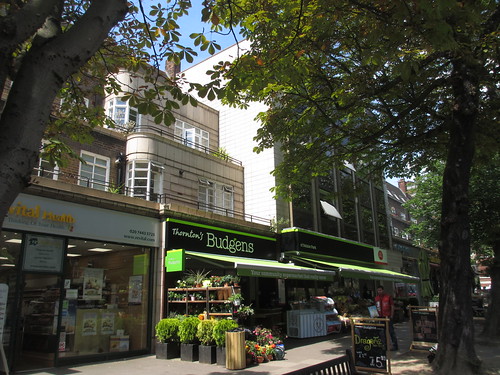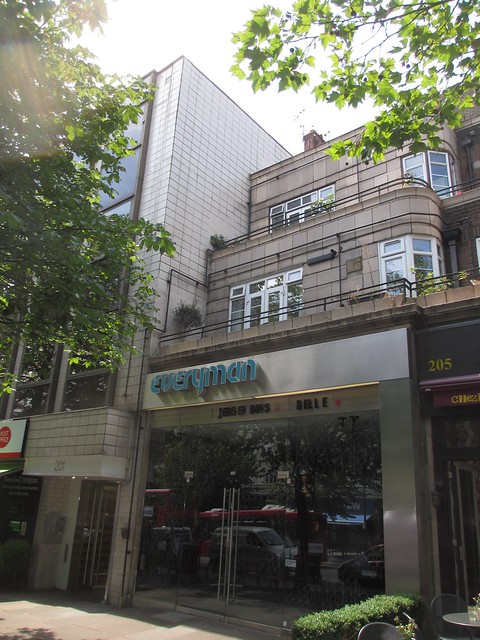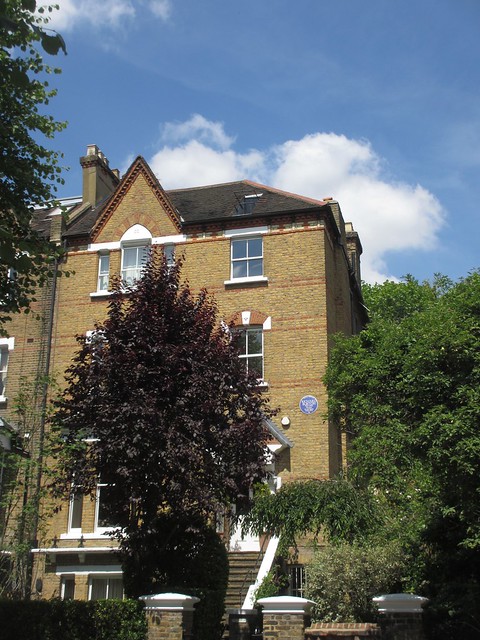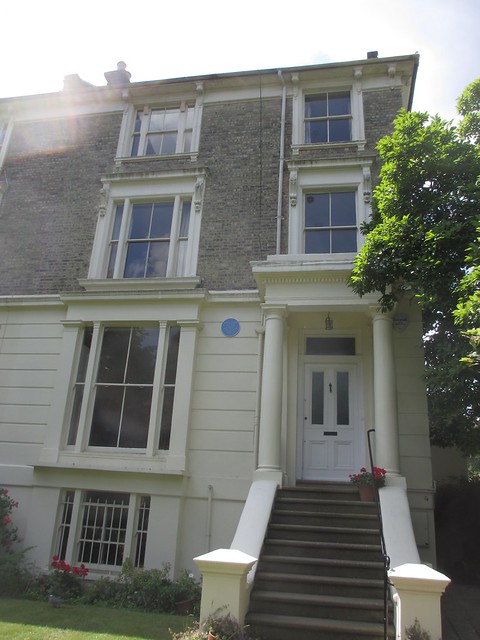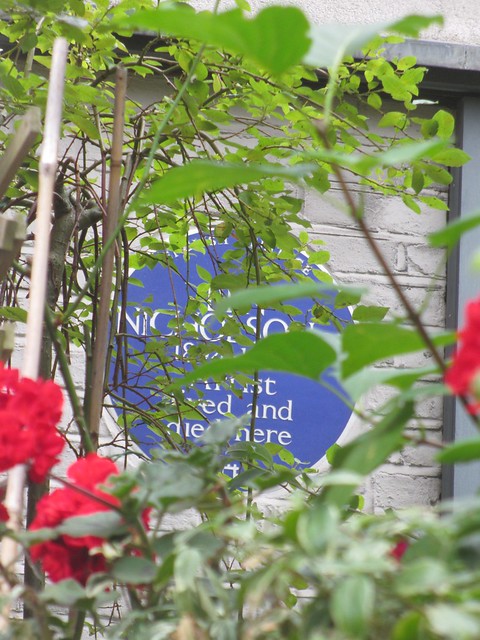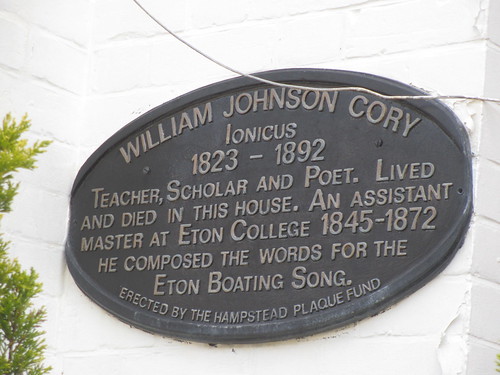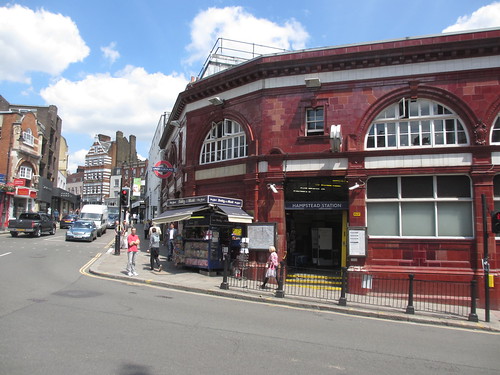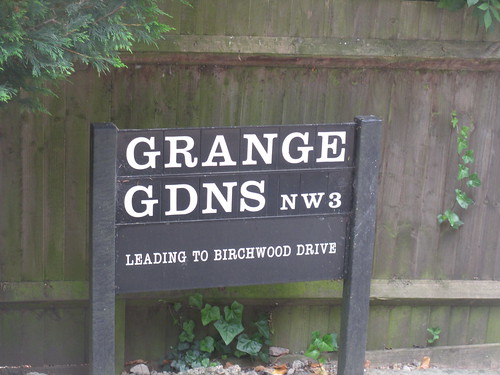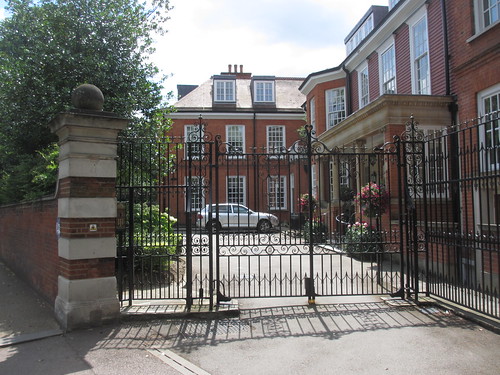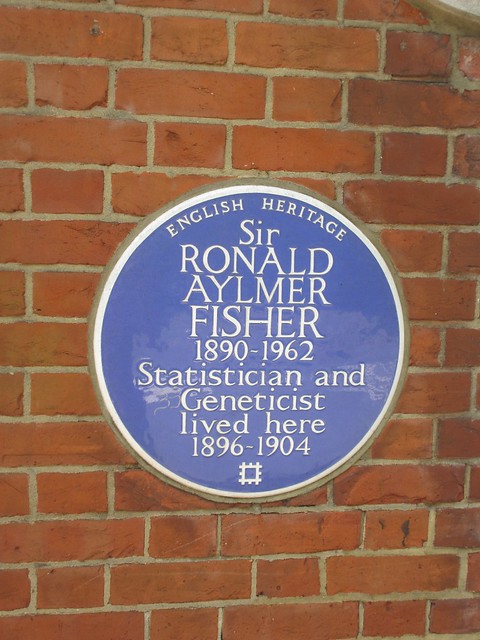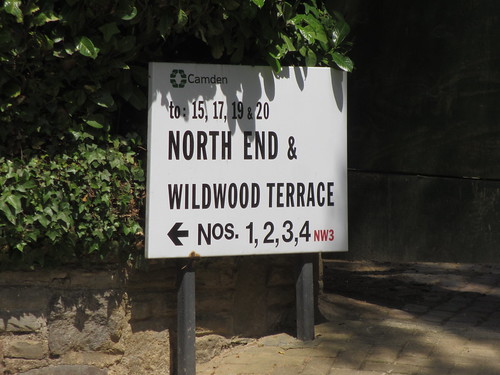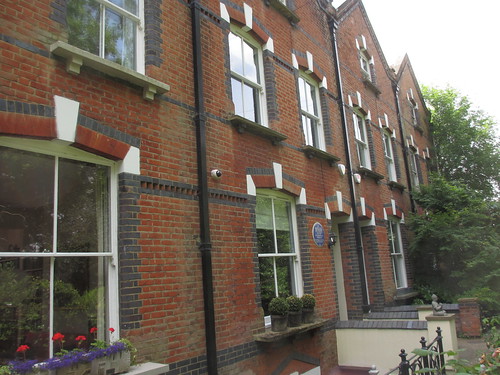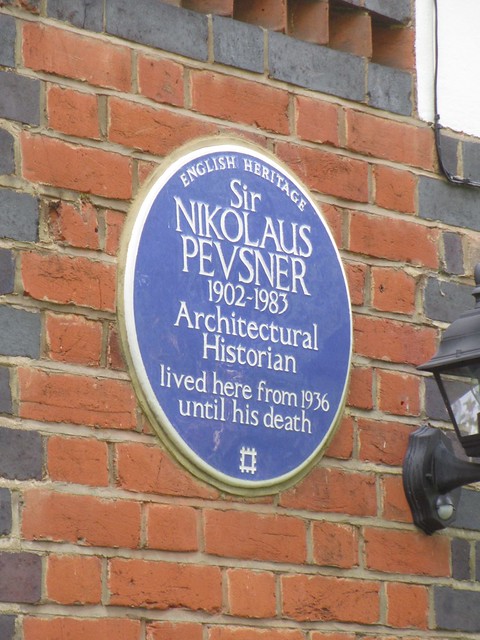NW3 is Hampstead and there is so much to say about the place and its famous residents of yesterday and today. It seems there is at least one blue plaque on every street in the centre of Hampstead village. In fact English Heritage lists over 60 blue plaques in NW3. So where do I begin?
I have decided to begin a little further down the hill in Belsize Park and walk though the village and end up at the old Bull and Bush, that pub immortalised in that old Music Hall song – although the story of that song is stranger than you might think.
Anyhow we start our walk at the Post Office which is in the middle of the parade of shops at 199 – 205 Haverstock Hill – opposite Belsize Park tube station. In fact this is our first stop.
Stop 1: Site of Haverstock Hill Odeon
This parade of shops, with flats above, was built in 1934. In the middle of it, where the Budgen supermarket and Post Office now stand, was once an Odeon cinema.
The cinema (variously known as Odeon Haverstock Hill, Odeon Belsize Park or Odeon Hampstead) opened on 29 September 1934. The art deco auditorium was unusual as it had no overhanging circle but was arranged in a stadium plan with 652 seats in the stalls and 892 in a rear raised balcony section.
The Odeon was badly damaged by a bomb in October 1941 and it did not reopen until December 1954. It carried on as an Odeon until it closed in September 1972. The cinema was demolished, leaving the rest of the parade of shops and flats remaining. A supermarket was built on the site. But in an interesting twist, one of the original shop units became the entrance to a new cinema in 1977 – initially called Screen on the Hill. This is still open although now called the Everyman Belsize Park.
Now walk up Haverstock Hill. It becomes Rosslyn Hill. Take the fourth turning on the left.
Stop 2: Number 6 Lyndhurst Road
Just to warn you Lyndhurst Road is numbered up one side and down the other. We are heading for Number 6 which is on the right hand side, a fair way (and beyond Eldon Grove).
This house was the home of the actor Richard Burton from 1949 to 1956.
This was a period when he was juggling a stage career with a Hollywood movie career – and before he met Elizabeth Taylor. She by the way called Burton one of the three loves of her life – the other two were her third husband Mike Todd and jewelry (sic). Elizabeth Taylor was actually born near here in 1932 at Heathwood, 8 Wildwood Road NW11 which is just on the edge of Hampstead Heath near the end of walk today. Her parents were american but they were living in London because of her father’s business.
Burton must have living here when he recorded “Under Milk Wood” for BBC radio in 1954. But by the time the film was made in 1972 he was long gone from here. Amazingly Elizabeth Taylor also featured in the 1972 movie version. I am intrigued to know what kind of Welsh accent she managed.
Retrace your steps as far as Eldon Grove and turn left down here.
Stop 3: Number 3 Eldon Grove
Our next stop is just on the left, at Number 3, former home of artist Paul Nash.
Paul Nash (1889 – 1946) was not just a painter but also a photographer, writer and designer of applied art. He is regarded as one of the important landscape artists of the first half of the twentieth century and he played a key role in the development of Modernism in English art. He was a war artist in both the first and second world wars. Tate has over 30 of his works and quite a few of these are on display.
http://www.tate.org.uk/art/artworks?aid=1690
Go to the end of Eldon Grove and turn right into Thurlow Road. At the end cross over Rosslyn Hill at the zebra crossing and turn left up the hill a short way. Then turn right into Pilgrim’s Lane.
Stop 4: Pilgrims Lane (Numbers 1, 2b and 8)
We have three interesting connections here. Number 1 on the left hand side was the home of painter Sir William Nicholson who lived here from 1904 to 1906.
Again the Tate has a lot of his work. They have a series of lovely lithographs from 1899 – here is his take on Queen Victoria:
http://www.tate.org.uk/art/artworks/nicholson-hm-the-queen-p08154
Across the road (and well hidden) is the house of Sir William’s son, Ben Nicholson (1894 – 1982).
In fact this was his last home and he died here on 6 February 1982. He was a painter of abstract compositions, landscape and still-life. The Tate has plenty of his work too. Strange he should end up just across the road from what must have been a childhood home, although he was probably away at school most of the time. It is easy to miss this one as the blue plaque is almost invisible from the street. You have to stand in front of Number 2 and crane your neck over the fence and through the foliage to see it!
And just a little further on from Number 2b is another plaque at Number 8 – this time not blue. And it is on a house which has a ship’s figurehead sticking out from it!
It commemorates William Johnson Cory – author of the words of the Eton Boat Song, although the figurehead is more the size for an ocean going ship than a rowing boat on the Thames. The Eton Boating Song dates from 1863 and features these words in the first verse:
“Swing swing together, With your bodies between your knees.”
(This is of course is a rowing reference)
Although he was certainly a teacher at Eton from 1845 to 1872, he was known then as William Johnson. He was forced to resign as a result of an indiscreet letter. The Dictionary of National Biography says “No one can be quite sure of the exact circumstances of his resignation,” but adds: “There is no question that he was dangerously fond of a number of boys.” It was perhaps easier to keep out of the papers in those days, especially when you had old boys in high places. Wonder what David and Boris know?
He changed his name to Cory, the maiden name of his paternal grandmother, then left the country and married and had a son. He moved here in 1882 where he lived out his last days.
Walk to the end of Pilgrim’s Lane and then turn right when you reach the Heath. Our next stop is just on the right.
Stop 5: Numbers 1 – 3 Willow Road
We have already seen Erno Goldfinger’s Trellick Tower in W10, but this is what he built in part for himself. This is in fact a terrace of three completed in 1939. The middle one was Goldfinger’s and is now owned by the National Trust. It is usually open Wednesday to Sunday http://www.nationaltrust.org.uk/2-willow-road/
For me, this design of building is so reminiscent of growing up in Crawley, where a huge part of the town was built in the 1950s very much in this style. This block looks like the schools I went to and there are features which remind me of the houses I lived in, although they were somewhat smaller than this!.
I have a soft spot for this style although in practical terms they were not great. These buildings were cold in winter and hot in summer and you always seems to get condensation on the windows. But those metal window frames are so well proportioned. It is sad that most have been replaced by clunky pvc, although it is understandable if you have to live or work in the building concerned.
By the way have a look in the first floor window of Number 2 and you can just see a mug with the word “genius” on it. Exactly.
Return along Willow Road and where it forks take the right hand road, Christchurch Hill, go along this until you reach Well Walk where you turn left. Our next stop is a little way on the left.
Stop 6: John Constable’s House, Well Walk
John Constable (1776 – 1837) was an English Romantic painter. He was born in Suffolk and he is best known for his landscape paintings of Dedham Vale – indeed that neck of the woods is now known as “Constable Country”.
Interestingly although he is most closely associated with Suffolk, he spent much of his life elsewhere including here in Hampstead and in fact he, his wife and two of their children are buried in the the nearby St John’s Church. He started coming to Hampstead in 1819 and leased this house in 1827. And he painted quite a lot here, much of which has ended up at the Tate: http://www.tate.org.uk/art/artworks/constable-hampstead-heath-with-the-house-called-the-salt-box-n01236
Continue along Well Walk and when you get to Willow Road there are two roads ahead. Take the right hand one which is Flask Walk.
Stop 7: Gardnor House, Flask Walk
By the way, Flask Walk and Well Walk are little reminders that Hampstead was once considered a spa. Though never up there with the big boys of Bath, Tunbridge Wells and Harrogate, I guess it was handy for London, as was Streatham which we saw in SW16.
Flask Walk widens out with a green in the middle. On the right is the old bathhouse and on the left is a detached house in its own grounds. This is Gardnor House. Once home to two very different people – at different times I might add.
One was the writer Sir Kingsley Amis (1922 – 1995). He wrote some 20 novels plus poetry, radio and television scripts and literary criticism. Although best remembered for novels such as Lucky Jim, he originally wished to be a poet, and turned to writing novels only after publishing several volumes of verse. He was well known to like a drink. For many years he is said to have rigorously separated his writing and his drinking. He aimed to write a minimum 500 words in the mornings and only then at lunchtime would the drinking begin.
The other was comedy actor, Betty Marsden (1919 – 1998), best known for playing multiple parts in the 1960s BBC radio series “Beyond our Ken” and “Round the Horne”. She did pop up in other things and was in a couple of Carry On films. Apparently throughout the filming of Carry on Camping in 1969, she suggested to fellow actress Dilys Laye that she wanted to die with a glass of gin in her hand. In July 1998, soon after moving into a residential home for old actors, she collapsed and died in the home’s bar.
Keep walking along Flask Walk, past the delightful Flask pub (wonder if Kingsley Amis or Betty Marsden popped in here)
At the end turn right and at the corner you will see our next stop.
Stop 8: Hampstead tube station
The station was opened on 22 June 1907 by the Charing Cross, Euston & Hampstead Railway, one of the three railways built by the american Charles Tyson Yerkes, and so has those distinctive red tiles.
It was originally going to be called Heath Street, being located at the junction of Heath Street and Hampstead High Street. The original tiled station signs on the platform walls had this name and although restored you can still read “Heath Street” on the platform wall.
The station platforms are the deepest on the London Underground network, at 58.5 metres or 192 feet below ground level. It has also the deepest lift shaft on the Underground at 181 feet. The staircase has some 320 steps – that’s quite a way.
Take the small side street opposite the tube station called Holly Hill. Use the right hand path passing the Sundial House. As the road widens out take the left hand road and then turn right and follow this road. Just after the road becomes Branch Hill you will see a gateway on the left. It looks like it is private but you can go down there.
Stop 9: location of Spedan Tower
Stick to the road and go past the big house. At the end you will see a sign for Spedan Close. (By the way the word Spedan is pronounced Speedan for reasons I will explain shortly)
Why Spedan Close? Well this is location of the mansion belonging to the store owner John Lewis. He was from Somerset and being orphaned at a young age was brought up by aunts, one of whom was called Ann Speed. Spedan is a word made up from reversing his aunt’s name. Hence it is pronounced Speedan. He not only called his house by this name but he also used it as a middle name for his eldest son, who was the one who really took the business forward.
John Lewis lived until his 90s and did not have the house modernised, so John Spedan Lewis found it old fashioned and gloomy. The house was therefore not kept and the land was sold for development, which is why you cannot see a big house here today.
Now if you do not mind a bit of a walk there is actually a plaque to Lewis father and son. It is not far from here but as the developments are gated you have to walk round a fair way to the other side.
From the Spedan Close sign follow the little lane to you right. This brings you back to Branch Hill. Turn left and continue to the junction with West Heath Road. If you want to skip this bit you would turn right here. But if you want to see the plaque turn left and follow the road until you reach Templewood Avenue on the left. You will come to Grange Gardens on the left. Go down here and ahead of you, you will soon see the sign for John Lewis and John Spedan Lewis.
Retrace your steps along Templewood Avenue and West Heath Road and keep following West Heath Road as it hugs the heath. Keep the heath to your left and soon you will be by Jack Straw’s Castle, a former pub but now apartments and a lifestyle centre.
Stop 10: Jack Straw’s Castle
Jack Straw’s Castle was one of those landmark pubs. There was a pub here for a long time at least since 1713 but possibly since Tudor times. The building we see today dates from the early 1960s; its predecessor having been destroyed by a bomb in 1941, an interesting choice of bomb target, don’t you think.
Here it is today.
But there are some other interesting pictures on this link
http://www.hampsteadheath.net/jack-straw-s-castle.html
Fascinating fact: Jack Straw was one of the leaders of the Peasant’s Revolt of 1381 along with Wat Tyler. This pub is said to have taken its name from a story that Straw addressed groups of rebels on the Heath from a hay wagon which became known as “Jack Straw’s Castle”.
Second fascinating fact: The politician we know as Jack Straw adopted the name “Jack”, allegedly after the rebel leader – he was called John Whitaker Straw by his parents.
Walk along the road in front of Jack Straw’s Castle, along North End Way. You will pass the former home of William Hesketh Lever, the soap man.
There is also another blue plaque here to someone I have never heard of.
Sadly we do not have space to include either of them!
Keep going along North End Way. Before you get to the Old Bull and Bush, take the turn on the right called Wildwood Grove.
A little way along you will see a small road going of to the left. Go down that and soon on the left you will see a tall gaunt Victorian terrace with just a footpath in front. You will see the second house in has a blue plaque.
Stop 11: Wildwood Terrace
This little terrace was built in the 1860s. Pevsner called this terrace “surprisingly urban gothic” and he should know, as he lived here for some 47 years.
Sir Nikolaus Pevsner (1902 – 1983) was a German-born scholar of history of art and architecture. He is of course best known for his series of county-by-county guides – The Buildings of England (1951–74). These are usually referred to as “Pevsner” and they form one of the key reference texts if you want to know about a building. As a guide I find them invaluable, but because they have been revised since his death, you are never entirely sure whether the withering statement about a building is his or not.
But it is intriguing that he should live in this out of the way terrace – imposing, no doubt spacious but not very special.
Now retrace your steps to the main road which has become North End Road. Turn right. Almost immediately is the next stop.
Stop 12: The Old Bull and Bush
Here we have the Old Bull and Bush – a fine old pub. There has been an ale house a long time. It got a license to sell ale in 1721 and Hogarth is said to have been a visitor. Later it bacame a favourite destination for day trips out from built up London. However this building dates largely from the 1920s.
As I mentioned at the start, the Old Bull and Bush was immortalised in an old Music Hall song. It was popularised by one Florrie Ford- other songs she sang included “Hold your hand out you naughty boy”, “Pack Up Your Troubles in Your Old Kit-Bag”, “It’s A Long Way To Tipperary” and “I Do Like To Be Beside The Seaside”.
She was born in Australia but made her name in the UK on the Music Hall circuit.
There is actually a film of her singing “The Old Bull and Bush” in a medley dating I guess from the 1930s. She is a portly lady – stately as a galleon in black with a hanky which shes flourishes. The Old Bull and Bush is the last minute or so – from about 3 minutes 18 Seconds:
(you will probably need to click on the link that pops up to make this work)
The song “The Old Bull and Bush” seems such a quintessentially British song,
But it is not. It is actually american. It was commissioned in 1903 by the brewer Anheuser Busch and the original words were:
“Come, come, come and make eyes at me, down at the Anheuser Bush (sic)”
Here is a link to a 1904 recording of the original song
So you never can tell.
You can stop here but there is a little something just round the corner I cannot resist.
Post script:
Now continue walking along North End Road and take the first turn on the right. this is Hampstead Way.
Stop 12a: North End (Bull and Bush) tube station
As Hampstead Way turns to he left there is what looks like an electricity sub-station.
But if you look closely at the signs they are in the standard underground style and suggest there is some kind of emergency escape route here. In fact we are at the top of a shaft which goes down to the platforms of North End station.
You may be wondering why you have never heard of North End station – or Bull and Bush station as it is sometimes called. That is because it was never finished and so it never opened to the public. Why? Because before they could finish the station, legislation was passed to protect a further section of Hampstead Heath and so the Underground company concluded there would not be enough traffic to justify the cost of finishing the station
There is a description of a visit to the site here (it is in two parts):
http://www.abandonedstations.org.uk/North_End_station.html
http://www.abandonedstations.org.uk/North_End_station2.html
As you stand here you may feel a rush of wind coming from the vent at the top. This is caused by a train passing by below you some three hundred feet.
So that brings us to the end of the NW3. There is so much more we could have seen. We did not get to Keats House, nor to Freud’s House, both now open to the public. We could not venture to the Isokon building, the former John Barnes department store nor to the Swiss Cottage. But I hope this has given a fair taste of NW3.
We are now around mid way between Hampstead and Golders Green stations, so you can go back to the former and forward to the latter. Or of course you could get a bus (268 to Hampstead or 210/268 to Golders Green)

